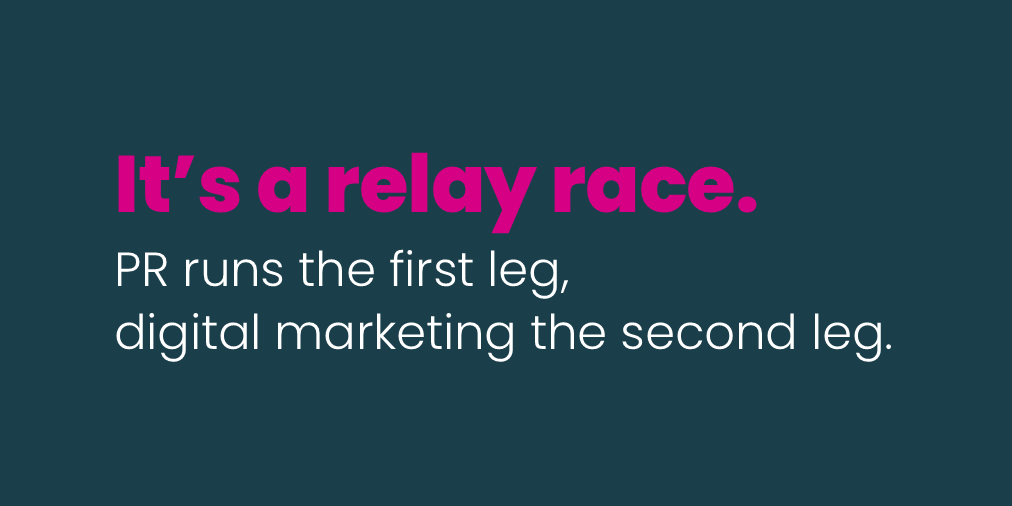
Financial PR and digital marketing: How they work together
In January the Lowe Group announced the formation of LG Digital, which formalizes and extends services we’ve previously offered. Pat Allen joined us to head the practice, bringing senior-level leadership and valuable varied experience.
Now that Jody and Pat are working together, we thought we’d have a chat about how financial PR and digital marketing work together.

Pat Allen: Jody, nobody blinked an eye when I told them I was joining a financial PR firm. I think that’s because most people intuitively get it. I could rattle off a list of where the two disciplines intersect: speed to market and the importance of timely communicating, distribution, reach, segmentation, amplification, measurement…
Jody Lowe: And don’t forget content. Content powers both investment company marketing communications and financial media relations outreach.
Content is often the crux of a media outreach effort. With new clients there can be a blind spot in understanding what a public relations effort needs to engage financial media. We often begin a new assignment by auditing a client’s content—what do they have, what do they need, can we repurpose a client-facing article or a sales deck into some sort of educational content? We regularly use the content that a brand’s digital marketing team is delivering.
Allen: I love your use of the word engage because that’s digital marketing’s job, too—another shared objective!
Lowe: Think about it. The reporter’s response when we pitch an expert might be to first check the subject matter expert out on the web. At a minimum, PR needs the proposed source’s bio to be on the firm’s website. But the vetting is further supported by the availability of content—a commentary or perspective—authored or co-authored by the source. Increasingly, media look at sources’ social media content as well after we’ve reached out.
It’s an even better scenario when, thanks to the brand’s digital marketing activities, the reporter comes across something in the wild and initiates a request. Now we’re in an even stronger position, and it can happen as a result of the content syndication, advertising or social media work of digital marketers.
Allen: Not everybody does all that. How much gets done is a function of both the size of the team and its mandate.
I’d argue that every investment firm needs some level of digital marketing from Day 1: A functioning website, an email capability, a social media presence. But at what point are they ready for media relations? I ask because I’ve seen banner ads promoting investment products or firms linking back to websites with the thinnest of landing pages.
Jody, from your perspective, which comes first—banner ads or PR?
Lowe: For an emerging asset manager that believes it has a unique message that warrants spending budget on either advertising or PR, we advocate thinking through whether you are prepared to respond, capture and convert any incoming leads. Assume the campaign will be successful and attract interest, will you have tools and content on the website to help potential clients with their buying decision? Once they become a client, do you have a process in place to continue to engage with them and keep them as clients? We’ve seen firms get ahead of themselves. Thinking through that client journey is a prerequisite to any promotional campaign. That said, we think PR can help raise awareness early, and later can work side by side to generate inbound leads from display ads.
Allen: What about orchestrating PR and digital marketing at larger, more established investment firms?
Lowe: Once you get to the billion-dollar RIAs, the challenge is often twofold—helping to build the overall brand of the company and separately building awareness for the firm’s individual advisor professionals. Often, it’s just a lack of awareness that some of the educational content shared with clients or speaking engagements, local radio appearances or podcasts needs to get on the website or shared on social. At advisory firms, marketing is often tilted toward supporting events. A digital marketing focus can make such a big difference in building an online presence for the individual advisors.
Then again, it’s an altogether different situation when we serve as an external media relations partner to in-house PR teams at large asset managers. There may be all kinds of initiatives underway, and we just need to hear about them. It’s why we advocate our biweekly meetings include a member from the various marketing communications teams, too. Thought leadership is happening at the corporate and business unit levels, and we love to hear about and leverage those assets.
Allen: Ah, can we talk about “thought leadership”? Over the years, I know some subject matter experts have resisted the term. What do you include in investment company thought leadership?
Lowe: Where do I begin? Quarterly investment commentary, speeches, client presentation decks, whitepapers outlining the investment opportunity in a specific region of the world or sector of the market. There is so much material regularly created for client or consultant use that can easily be repurposed into a website article, blog post, LinkedIn article or whitepaper.
Allen: And what about straight-up product communications from mutual fund and ETF marketing teams? Can you use those? Are reporters covering investment companies interested?
Lowe: There is an art to making sure your content isn’t too self-serving. Our colleague Ben Bishop just wrote about this topic. If content is too salesy, it is hard for us to use it with the media. Sometimes just recasting these materials to be slightly more educational is all you need to do. However, we regularly make use of mutual fund fact sheets when pitching investment professionals as they often contain important background, investment performance and top holdings that might be of interest to a reporter working on a story.
Allen: So far, we’ve focused on what PR needs to reach out to the media, but there’s more to it as far as what digital marketing may need from PR. I believe that the appearance of a favorable media mention or interview—the very achievement of the PR team’s work—is when digital marketing needs to mobilize. From my perspective, it’s a drop everything moment. It’s time to jump on it, create a social post or even blog post, order online reprints, the whole enchilada. The interview took place on a different property, but let’s bring it to our domain, where we can track and measure interest in it.
Lowe: So many of our clients want to know how they can “measure” the results of PR. I’ve learned so much from you about how partnering with digital marketing is a critical way to gather KPIs. We’ve seen two clients get the very same opportunity and one will get much more value from it because their digital team was locked in on it, leveraged it and tracked the results. That’s one reason we’re so excited you joined, Pat. You will be able to help our clients who aren’t fully optimizing those hard-won PR wins and maximize them.
Allen: I think of it as a relay race. PR runs the first leg, digital marketing the second leg, and then an intermediary sales team can run with the opportunity, whether they share the firm’s social posts or send their own emails. Media appearances are one more way to engage and build credibility. It’s yet another interaction for firms that are trying to wire together all engagement points in the CRM, and it can be useful for sales in finetuning the relevance of their next outbound communication.
Can we touch on social media and PR? Digital marketers at investment firms are focused on LinkedIn because it’s the undisputed platform for financial advisors. Are financial reporters on LinkedIn, too?
Lowe: Most media are active and engaged on Twitter. While LinkedIn is more about networking and connections, Twitter is much more of the moment and news focused. We see a lot of financial influencers building a presence on Twitter. We also see media looking for sources and sharing their stories there.
While leaders in the tech world are all over Twitter, fewer investment industry professionals use the platform. They are less aware of the engagement opportunity of sharing tweets or the website traffic that can result. We think it can be a worthwhile addition to social media efforts, including smart hashtag use. A few investment professionals such as Bianco Research’s Jim Bianco, Cambria’s Meb Faber, Schwab’s Liz Ann Sonders, Mohamed A. El-Erian and Morningstar’s Christine Benz have built real followings on Twitter. You can ignore it, but it might mean you’ll fly under the radar.
What are your thoughts on how PR and digital marketing work together? Can we help facilitate at your firm? Send us an email.
Subscribe.
Receive the latest news and insights from Lowe Group.